Welcome to my experiment in baking with beer yeast you guys. Especially if you are a brewer, I can wholeheartedly recommend using dry brewing yeast for bread baking. You can also learn more about the function of yeast in general
More baking with brewers yeast with my Champagne Yeast Pita and Champagne Yeast Brioche.
For ease of browsing, you can find all my bread recipes in one place. Thanks for being here!

Want to refer back to this post?
Baking with Brewers’ Yeast Pinterest Link
The beginnings of a plan
Sometimes I get crazy ideas. Sometimes these ideas don’t work out. But a few weeks ago, I actually had a good crazy idea. I thought that it would be Fun to experiment with different strains of brewers’ yeast in my bread.
Pastry Chef Online Participates in Affiliate Programs. If you make a purchase through one of my links, I may earn a small commission. For more information click to read my disclosure policy
Granted, bakers’ yeast has been optimized for baking, so I guess it’s a fan of the particular sugars present in wheat flour.
But all yeasts eat sugars and expel carbon dioxide and alcohol. I figured that trying to bake with beer yeast might be a fun experiment.
The Beloved and I took a trip out to the local home brew store, American Brewmaster. I came home with a veritable Treasure Trove of goodies.
I bought three kinds of yeast, some Belgian candy sugar (which sat on the sidelines during this experiment–I kind of forgot about it), and some dry malt extract.
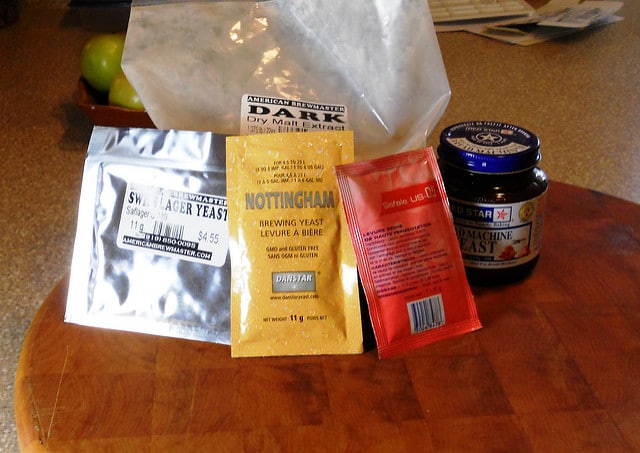
I was going to get the syrupy malt extract, but The Guy told me that it is Very Susceptible to bacterial infiltration and just to get the dried. I sullenly accepted his advice.

So, then, there they were. All my ingredients. Facing me. Day after day. Finally, after a couple of weeks, I broke down and decided that That Day was The Day. I decided to be kind of scientific-y about the whole thing.
Getting started (and get in touch)
I used exactly the same ingredients in the same proportions for each dough. The only difference was the type of yeast I used.
I also labeled everything and gave all the dough the same amount of rise time both on the counter and in the fridge.
Read on to learn everything you want to know about baking with brewers yeast.
And if you don’t find what you’re looking for, email me. Seriously.
About this dough
Incidentally, this is a fantastic wet-ish dough. The long, uber-slow rise helps to develop some really nice chew and flavor, even using all purpose flour.
Even if you’re not feeling Up to the whole brewers’ yeast thing, this recipe makes a great loaf that weighs about 1 1/2 pounds.
This recipe yields a chewy bread with a reasonably open crumb. If you are looking for a sandwich bread, try my Spent Grain Bread and use brewers’ yeast rather than bread yeast.
Supplies you may need
Here are some recommendations for brewer’s yeast and other products and ingredients you can use in baking bread to enhance flavor or switch up the flavor profile a bit. Not all your experiments will be perfect, but you’ll always learn something.
Some good yeasts to start with are SafAle Ale Yeast, the Nottingham yeast (the one that made the bread smell like oatmeal), and of course the lager yeast, that loves the cold anyway.
You may also want to check out this Mangrove Jack’s US West Coast dry yeast.
Consider picking up some malt powder or even some rock sugar for feeding the yeast. I also have added a link for a reliable instant read thermometer, a high quality but reasonably priced kitchen scale, and a lamé for scoring bread.
I consider the thermometer and the scale to be essential kitchen tools, whether baking bread of not. And the lamé is certainly nice to have if you do a lot of bread baking.
Basic bread ingredients for this experiment (per loaf):
- 15 oz all purpose flour (I used King Arthur)
- 9 oz cool warm-ish water (about 100F)
- 1 teaspoon salt
- 1 teaspoon dry malt extract (feel free to substitute molasses, honey, sugar, maple syrup–whatever type of sugar you want)
- 1/4 teaspoon dried yeast
Procedure
NOTE: I made 4 separate loaves with 15 oz flour each to make it easier to blend the yeast into each loaf.
First, weigh out your flour.
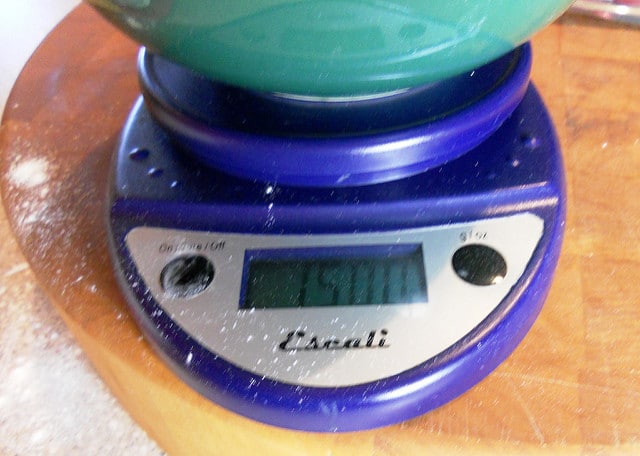
Choose your yeast. You’ll only be using 1/4 teaspoon.
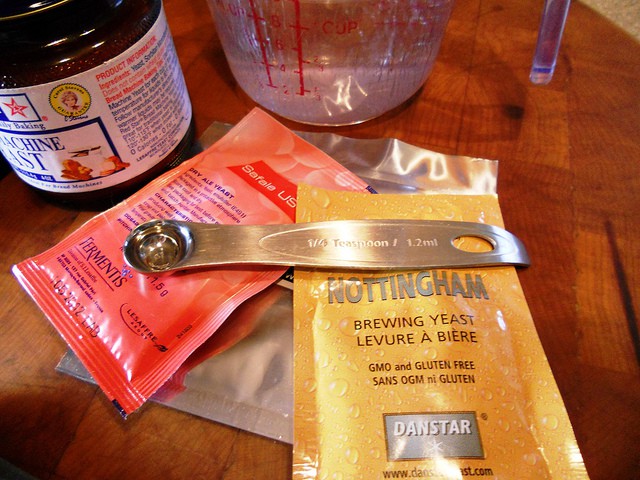
Salt and malt extract go into each loaf.
Would you like to save this post?
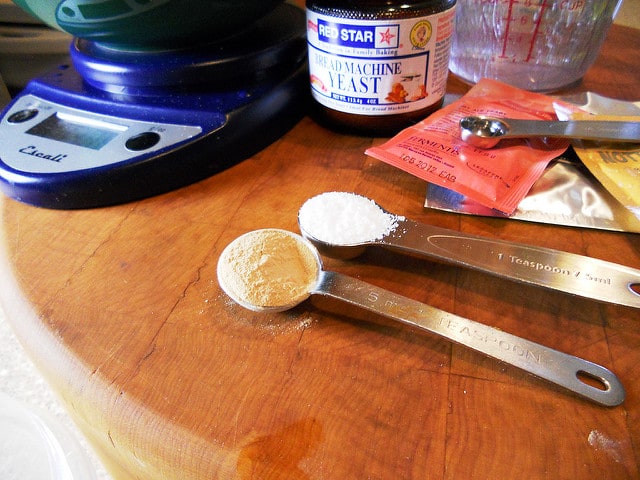
And 9 ounces of water. If you don’t have a scale or a liquid measure with accurate markings, use 1 cup (carefully filled to the top) plus 2 tablespoons of water. (Again, please buy a scale.)
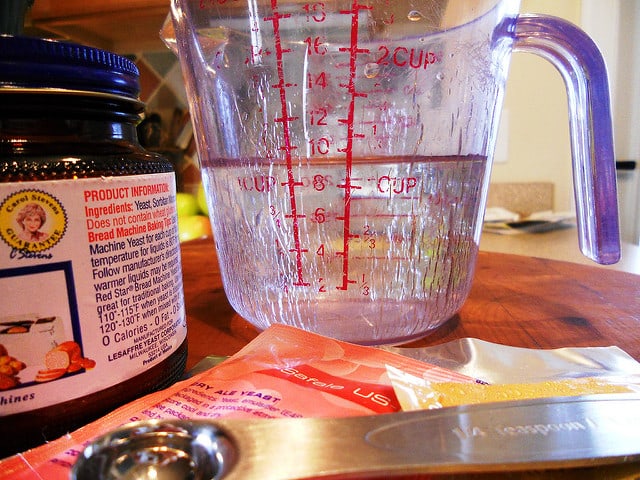
Whisk together dry ingredients in a mixing bowl. Turn on your mixer (fitted with the dough hook) to low speed and mix for three minutes.
Raise the speed to medium and knead for seven minutes.
**What follows is the rising schedule I used to bring out as much flavor as possible. If you don’t have the time, increase the yeast to 1-2 teaspoons and let it rise once until doubled.
Punch down, shape, let rise again and then bake. Let the last rise happen in a greased 1 pound loaf pan if you want a taller loaf. Since this dough is pretty loose, it tends to spread a bit.
Apocalyptic rising schedule
- Put each dough in a 1-gallon zip top bag. Label (!) and let rise in a cool kitchen (65F) for 3 1/2 hours
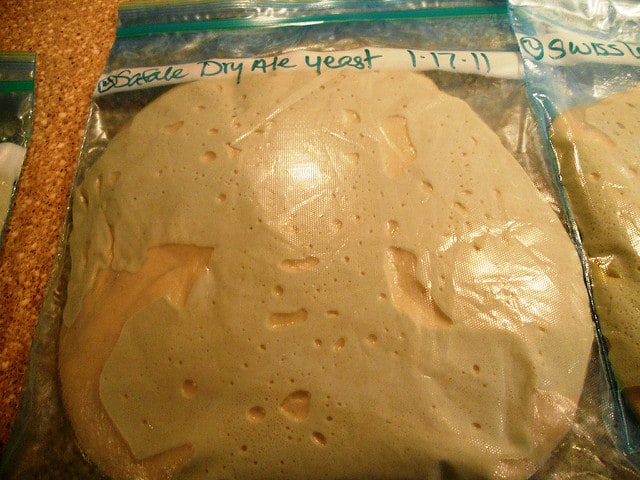
- Transfer to the fridge–don’t stack them–and let rise for a long over-night. Mine rose for about 10 hours.
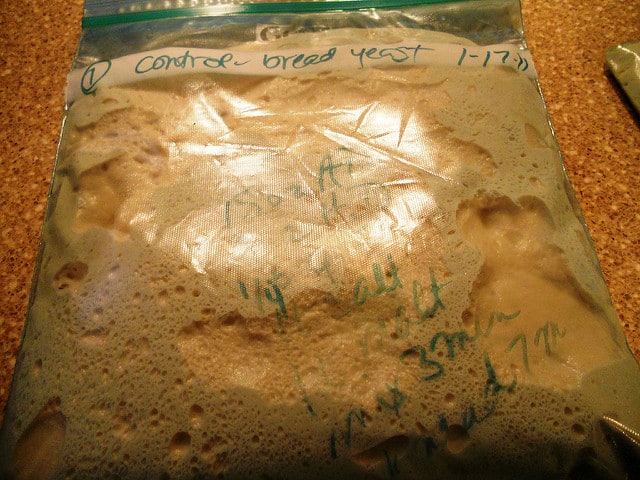
- In the morning, put them back on the counter for 3 hours.
- Oil your hands. Take each piece of dough out of its pouch. Punch each piece down and knead a few times to redistribute the yeast. Round, oil and cover. Let rise again for 3 hours.
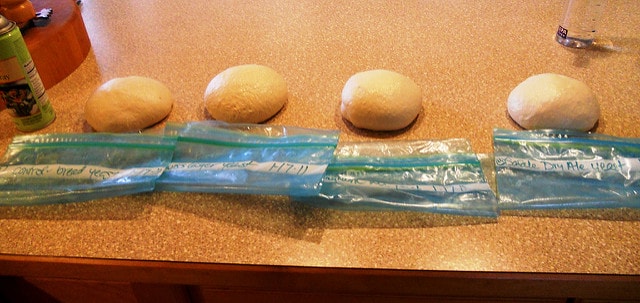
- Punch down again, press out all (most) of the large air bubbles, and shape. Oil and cover. Let rise on a prepared baking sheet for another 1 1/2 hours OR
- Shape lightly and don’t press out the gases for a loaf with a more “artisinal” open-crumbed texture.
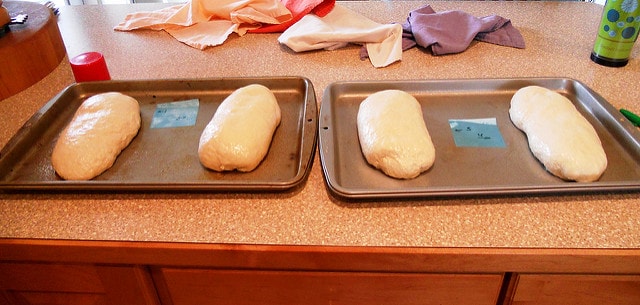
- Slash with your lame (if you want) and bake at 350F for 25 minutes.
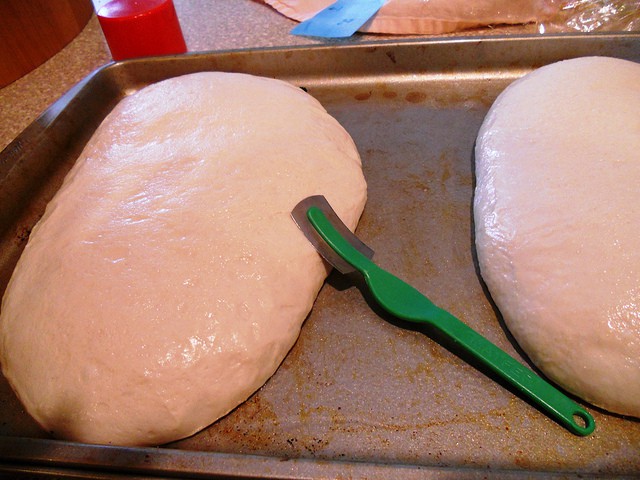
- Remove from baking sheets and finish them directly on the racks for another 10-15 minutes, or until the internal temperature is 200-205F.
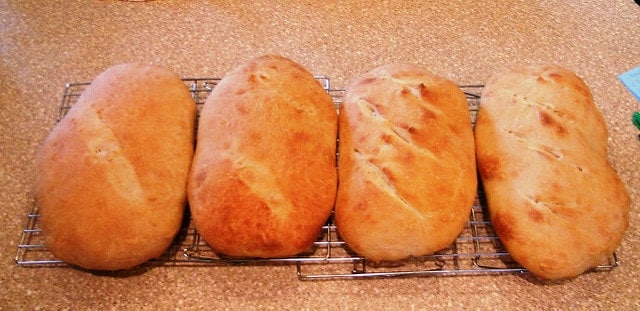
- Let cool completely on racks. Slice and freeze.
Since this dough is so slack and sticky, make sure to oil (or spray Pam on) your hands to keep it from sticking (to you or the counter) or to help you resist the urge to add more flour.
You Can’t Make This with Brewers Yeast Supplement
I had a reader message me to say their yeast wasn’t working. Then they sent a photo of a brewers yeast supplement they were trying to use.
Please note: the supplement version of brewers yeast will not work in this recipe or any other bread recipe, if you want to use it as the leavening agent.
This type of nutritional supplement is an inactive form of yeast. Otherwise, you’d have a tummy full of alcohol and would be burping carbon dioxide for who knows how long!
Takeaways
So, what did I learn from my experiment of baking with beer yeast? Well, I learned lots of stuff.
- Each yeast lends a slightly different character to the dough.
- The differences that I noted were fairly subtle. I could only really detect them in side by side tests.
- Lager yeast definitely enjoys being in the fridge. Lagers ferment at a lower temperature than ales, so it makes sense that the lager yeast was pretty happy in the fridge and in our 65F kitchen.
- Bread made with Nottingham ale yeast smells like oatmeal. This is a Very Good Thing.
- The loaf made with the bread yeast (the Control Loaf), while still tasty, was the least interesting of the four loaves. Sorry, bread yeast. I can absolutely Quit You.
- This base recipe would absolutely make the best baguettes. Try it. A twitter friend uses the Safale Dry Ale yeast in her baguettes. It yielded a pretty fine and regular crumb–perfect for baguettes.
- You can never have too much bread in the house.
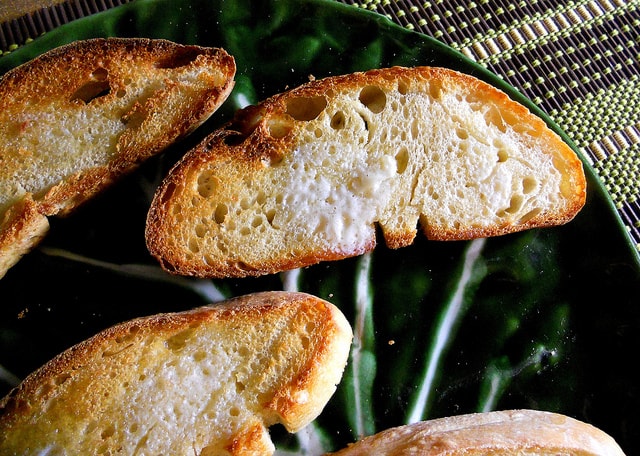
Don't let its small price and small size fool you. The Escali Primo is an accurate and easy-to-use food scale that I have used for years. It's easy to store, easy to use, has a tare function, and easily switches between grams and ounces/pounds for accurate measurements.
It will help me and other readers so much if you take a moment to rate and leave a review for this recipe.
You can use the stars to rate 1-5 (5 is best), and leave a review in the comments. It helps me make adjustments if any are needed, and comments help others decide whether the recipe is worth making.
Other ways to share include pinning, and/or sharing on your favorite social media platform.
Thank you so much for taking the time!


Bread Made with Beer Yeast
Would you like to save this post?
Ingredients
- 15 oz all purpose flour I used King Arthur
- 9 oz water just above body temperature
- 1 teaspoon salt
- 1 teaspoon dry malt extract or powder or sweetener of choice
- ¼ teaspoon active dry yeast
Instructions
- Whisk together dry ingredients in a mixing bowl.
- Pour the water on top.
- Turn on your mixer (fitted with the dough hook) to low speed and mix for three minutes.
- Raise the speed to medium and knead for seven minutes.
Rising Schedule I Used
- Put dough in a 1-gallon zip top bag. (See Notes) Label (!) and let rise in a cool kitchen (65F) for 3 1/2 hours
- Transfer to the fridge and let rise for a long over-night. Mine rose for about 10 hours.
- In the morning, put the dough still in the bag on the counter for 3 hours.
- Take dough out of its pouch.
- Oil your hands, and punch down and knead a few times to redistribute the yeast. Round the loaf, oil and cover.
- Let rise again for 3 hours.
- Punch down again, press out all (most) of the large air bubbles, and shape.
- Oil and cover. Let rise on a prepared baking sheet for another 1 1/2 hours
- If you prefer, you can shape lightly and don’t press out the gases for a loaf with a more “artisinal” open-crumbed texture.
- Slash (if you want) and bake at 350F for 25 minutes.
- Remove from baking sheet and finish the loaf directly on the rack for another 10-15 minutes, or until the internal temperature is 200-205F.
- Let cool completely on rack.
- Slice and enjoy.
Did You Make Any Changes?
Notes
To Freeze
If you do not intend to eat or share the whole loaf within a day, slice it and then freeze in a heavy duty zip top bag. Then you can remove slices as needed. The bread will keep in the freezer for about 3 months. To thaw, take out the pieces you need and allow them to come to room temperature. You can also toast the bread from frozen or microwave it for just a few seconds to thaw it out more quickly.Nutrition

Hi, y’all! I hope you’ve enjoyed this post and hopefully also learned a thing or two.
If you like my style, I invite you to sign up for my occasional newsletter, The Inbox Pastry Chef.
Expect updates on new and tasty recipes as well as a bit of behind-the-scenes action. I hope to see you there!
Enjoy experimenting with baking with brewers yeast, and have a lovely day!



Join in Today!
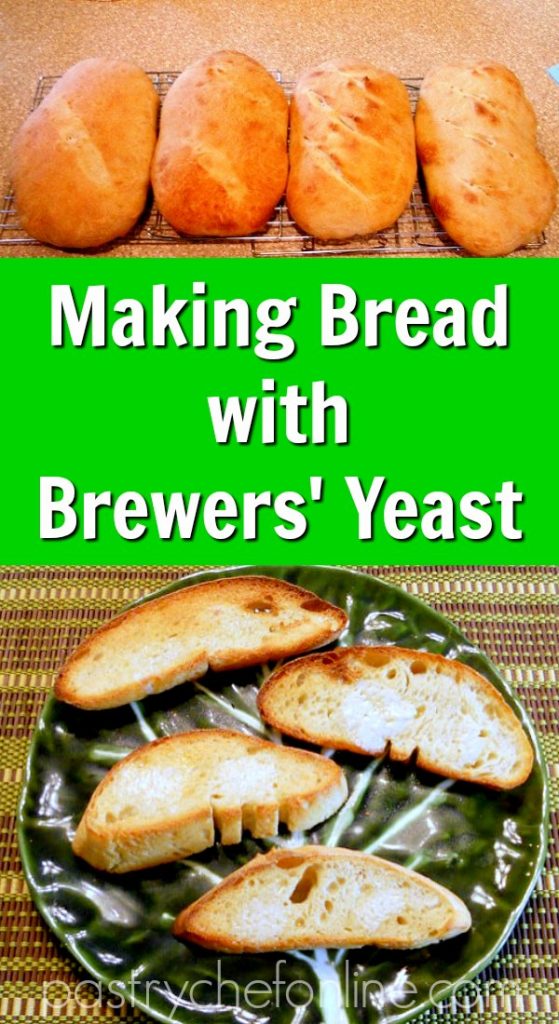


I’m so glad I found this, and thank you for posting, Jenni. I am interested in brewing a beer and baking bread that have the same yeast and malt. I’m going to have to turn my malted grains from the homebrew shop into flour, but I’m excited to see how they taste similar! Would love to know if you’ve ever done anything similar. Thanks!
Hey, Ana! I’m so glad you found this post too! I haven’t done what you propose, mainly because I’m not a brewer, but it is definitely a natural extension of the experiment! I also have a brewer’s bread made with still-wet spent grains, so you may be able to incorporate both the same yeast and the spent grains into your loaf: https://pastrychefonline.com/brewers-bread/ I hope you’ll let me know how your experiments turn out!